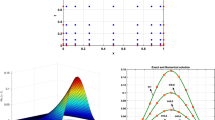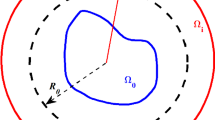Abstract
In this paper, we propose a high-performance implementation of a space-fractional FitzHugh–Nagumo model. Our implementation is based on a positivity- and boundedness-preserving finite-difference model to approximate the solutions of a Riesz space-fractional reaction-diffusion equation. The model generalizes the FitzHugh–Nagumo model. The stability and convergence of the difference scheme are thoroughly discussed. Moreover, we prove the existence and uniqueness of numerical solutions, positivity, boundedness and consistency of the model. The scheme is based on weighted and shifted Grünwald differences. The conjugate gradient method is used then to solve the sparse matrix system. The MPI and PETSc libraries are used for the computational implementation. We investigate the influence of some computer factors on the performance of our implementation and scalability. More precisely, we consider the number of cores, the size of the computation mesh and the orders of the fractional derivatives. Tests are evaluated on a ccNUMA architecture with two CPUs.






Similar content being viewed by others
References
Al-Ghoul M, Eu BC (1996) Hyperbolic reaction- diffusion equations, patterns, and phase speeds for the Brusselator. J Phys Chem 100(49):18900–18910
Balay S, Gropp WD, McInnes LC, Smith BF (1997) Efficient management of parallelism in object oriented numerical software libraries. In: Arge E, Bruaset AM, Langtangen HP (eds) Modern software tools in scientific computing. Birkhäuser Press, Basel, pp 163–202
Balay S, Abhyankar S, Adams MF, Brown J, Brune P, Buschelman K, Dalcin L, Eijkhout V, Gropp WD, Kaushik D, Knepley MG, May DA, McInnes LC, Mills RT, Munson T, Rupp K, Sanan P, Smith BF, Zampini S, Zhang H, Zhang H (2018) PETSc Web page.http://www.mcs.anl.gov/petsc, http://www.mcs.anl.gov/petsc
Balay S, Abhyankar S, Adams MF, Brown J, Brune P, Buschelman K, Dalcin L, Eijkhout V, Gropp WD, Kaushik D, Knepley MG, May DA, McInnes LC, Mills RT, Munson T, Rupp K, Sanan P, Smith BF, Zampini S, Zhang H, Zhang H (2018) PETSc users manual .Tech. Rep. ANL-95/11—revision 3.9, Argonne National Laboratory. http://www.mcs.anl.gov/petsc
Barbera E, Consolo G, Valenti G (2013) Spread of infectious diseases in a hyperbolic reaction-diffusion susceptible-infected-removed model. Phys Rev E 88(5):052,719
Biancalani T, Fanelli D, Di Patti F (2010) Stochastic Turing patterns in the Brusselator model. Phys Rev E 81(4):046,215
Cartwright JH (2002) Labyrinthine Turing pattern formation in the cerebral cortex. J Theor Biol 217(1):97–103
Chen S, Liu F, Turner I, Anh V (2013) An implicit numerical method for the two-dimensional fractional percolation equation. Appl Math Comput 219(9):4322–4331
Cho UI, Eu BC (1993) Hyperbolic reaction-diffusion equations and chemical oscillations in the Brusselator. Phys D 68(3–4):351–363
Coillet A, Balakireva I, Henriet R, Saleh K, Larger L, Dudley JM, Menyuk CR, Chembo YK (2013) Azimuthal Turing patterns, bright and dark cavity solitons in Kerr combs generated with whispering-gallery-mode resonators. IEEE Photonics J 5(4):6100,409–6101,409
Consolo G, Currò C, Valenti G (2017) Pattern formation and modulation in a hyperbolic vegetation model for semiarid environments. Appl Math Model 43:372–392
Datsko B, Luchko Y, Gafiychuk V (2012) Pattern formation in fractional reaction-diffusion systems with multiple homogeneous states. Int J Bifurc Chaos 22(04):1250,087
De Wit A (2007) Spatial patterns and spatiotemporal dynamics in chemical systems. Adv Chem Phys 109:435–513
Dufiet V, Boissonade J (1996) Dynamics of Turing pattern monolayers close to onset. Phys Rev E 53(5):4883
Eftimie R (2012) Hyperbolic and kinetic models for self-organized biological aggregations and movement: a brief review. J Math Biol 65(1):35–75
Ervin VJ, Macías-Díaz JE, Ruiz-Ramírez J (2015) A positive and bounded finite element approximation of the generalized Burgers–Huxley equation. J Math Anal Appl 424(2):1143–1160
Fujimoto T, Ranade RR (2004) Two characterizations of inverse-positive matrices: the Hawkins–Simon condition and the Le Chatelier–Braun principle. Electron J Linear Algebra 11(1):6
Gafiychuk V, Datsko B (2008) Spatiotemporal pattern formation in fractional reaction-diffusion systems with indices of different order. Phys Rev E 77(6):066
Glöckle WG, Nonnenmacher TF (1995) A fractional calculus approach to self-similar protein dynamics. Biophys J 68(1):46–53
Gong C, Bao W, Tang G (2013) A parallel algorithm for the Riesz fractional reaction-diffusion equation with explicit finite difference method. Fract Calc Appl Anal 16(3):654–669
Henry BI, Wearne SL (2002) Existence of Turing instabilities in a two-species fractional reaction-diffusion system. SIAM J Appl Math 62(3):870–887
Isaeva OB, Kuznetsov AS, Kuznetsov SP (2013) Hyperbolic chaos of standing wave patterns generated parametrically by a modulated pump source. Phys Rev E 87(4):040,901
Koeller R (1984) Applications of fractional calculus to the theory of viscoelasticity. ASME Trans J Appl Mech (ISSN 0021-8936) 51:299–307
Kondo S, Miura T (2010) Reaction-diffusion model as a framework for understanding biological pattern formation. Science 329(5999):1616–1620
Langlands T, Henry B, Wearne S (2007) Turing pattern formation with fractional diffusion and fractional reactions. J Phys Condens Matter 19(6):065,115
Lutscher F, Stevens A et al (2002) Emerging patterns in a hyperbolic model for locally interacting cell systems. J Nonlinear Sci 12(6):619–640
Macías-Díaz JE (2011) Sufficient conditions for the preservation of the boundedness in a numerical method for a physical model with transport memory and nonlinear damping. Comput Phys Commun 182(12):2471–2478
Macías-Díaz JE (2017) Persistence of nonlinear hysteresis in fractional models of Josephson transmission lines. Commun Nonlinear Sci Numer Simul 53:31–43
Macías-Díaz JE (2018) A bounded and efficient scheme for multidimensional problems with anomalous convection and diffusion. Comput Math Appl 75(11):3995–4011
Macías-Díaz J, Puri A (2010) A boundedness-preserving finite-difference scheme for a damped nonlinear wave equation. Appl Numer Math 60(9):934–948
Macías-Díaz J, Villa-Morales J (2017) A deterministic model for the distribution of the stopping time in a stochastic equation and its numerical solution. J Comput Appl Math 318:93–106
Markov N, Ushenin K, Hendy A (2016) Performance evaluation of space fractional fitzhugh-nagumo model: An implementation with petsc library. CEUR Workshop Proc 1729:66–77
Meerschaert MM, Tadjeran C (2004) Finite difference approximations for fractional advection-dispersion flow equations. J Comput Appl Math 172(1):65–77
Meerschaert MM, Tadjeran C (2006) Finite difference approximations for two-sided space-fractional partial differential equations. Appl Numer Math 56(1):80–90
Morales-Hernández MD, Medina-Ramírez IE, Avelar-González FJ, Macías-Díaz JE (2012) An efficient recursive algorithm in the computational simulation of the bounded growth of biological films. Int J Comput Methods 9(04):1250,050
Mvogo A, Macías-Díaz JE, Kofané TC (2018) Diffusive instabilities in a hyperbolic activator-inhibitor system with superdiffusion. Phys Rev E 97(3):032,129
Namias V (1980) The fractional order Fourier transform and its application to quantum mechanics. IMA J Appl Math 25(3):241–265
Nec Y, Nepomnyashchy A (2007) Turing instability in sub-diffusive reaction-diffusion systems. J Phys A Math Theor 40(49):14,687
Ortigueira MD (2006) Riesz potential operators and inverses via fractional centred derivatives. Int J Math Math Sci 2006:48391
Pena B, Perez-Garcia C (2001) Stability of Turing patterns in the Brusselator model. Phys Rev E 64(5):056,213
Pertsov AM, Davidenko JM, Salomonsz R, Baxter WT, Jalife J (1993) Spiral waves of excitation underlie reentrant activity in isolated cardiac muscle. Circ Res 72(3):631–650
Pimenov VG, Hendy AS, De Staelen RH (2017) On a class of non-linear delay distributed order fractional diffusion equations. J Comput Appl Math 318:433–443
Polyanin AD, Zaitsev VF (2016) Handbook of nonlinear partial differential equations. Chapman and Hall/CRC, Boca Raton
Povstenko Y (2009) Theory of thermoelasticity based on the space-time-fractional heat conduction equation. Phys Scr 2009(T136):014,017
Rudovics B, Barillot E, Davies P, Dulos E, Boissonade J, De Kepper P (1999) Experimental studies and quantitative modeling of turing patterns in the (chlorine dioxide, iodine, malonic acid) reaction. J Phys Chem A 103(12):1790–1800
Rudovics B, Dulos E, De Kepper P (1996) Standard and nonstandard Turing patterns and waves in the CIMA reaction. Phys Scr 1996(T67):43
Scalas E, Gorenflo R, Mainardi F (2000) Fractional calculus and continuous-time finance. Phys A 284(1):376–384
Song F, Xu C, Karniadakis GE (2016) A fractional phase-field model for two-phase flows with tunable sharpness: algorithms and simulations. Comput Methods Appl Mech Eng 305:376–404
Su N, Nelson PN, Connor S (2015) The distributed-order fractional diffusion-wave equation of groundwater flow: theory and application to pumping and slug tests. J Hydrol 529:1262–1273
Tang X, Song Y (2015) Bifurcation analysis and Turing instability in a diffusive predator-prey model with herd behavior and hyperbolic mortality. Chaos, Solitons & Fractals 81:303–314
Tarasov VE (2006) Continuous limit of discrete systems with long-range interaction. J Phys A Math Gen 39(48):14,895
Tarasov VE, Zaslavsky GM (2008) Conservation laws and Hamiltons equations for systems with long-range interaction and memory. Commun Nonlinear Sci Numer Simul 13(9):1860–1878
Tian W, Zhou H, Deng W (2015) A class of second order difference approximations for solving space fractional diffusion equations. Math Comput 84(294):1703–1727
Wang X, Wang W, Zhang G (2017) Vegetation pattern formation of a water-biomass model. Commun Nonlinear Sci Numer Simul 42:571–584
Wolfrum M (2012) The Turing bifurcation in network systems: collective patterns and single differentiated nodes. Phys D 241(16):1351–1357
Xu J, Yang G, Xi H, Su J (2015) Pattern dynamics of a predator-prey reaction-diffusion model with spatiotemporal delay. Nonlinear Dyn 81(4):2155–2163
Yang L, Epstein IR (2003) Oscillatory Turing patterns in reaction-diffusion systems with two coupled layers. Phys Rev Lett 90(17):178,303
Zhang T, Xing Y, Zang H, Han M (2014) Spatio-temporal dynamics of a reaction-diffusion system for a predator-prey model with hyperbolic mortality. Nonlinear Dyn 78(1):265–277
Zhao X, Hu X, Cai W, Karniadakis GE (2017) Adaptive finite element method for fractional differential equations using hierarchical matrices. Comput Methods Appl Mech Eng 325:56–76
Acknowledgements
The authors want to thank the anonymous reviewers and the associate editor in charge of handling this submission for their time and efforts in evaluating this manuscript. Their comments were very helpful in improving substantially the overall quality of this work. The present work reports on a set of results of the research project “conservative methods for fractional hyperbolic systems: analysis and applications”, funded by the National Council for Science and Technology of Mexico through grant A1-S-45928. The second author acknowledges the support of RFBR Grant 19-01-00019.
Author information
Authors and Affiliations
Corresponding author
Additional information
Publisher's Note
Springer Nature remains neutral with regard to jurisdictional claims in published maps and institutional affiliations.
Implicit formulas
Implicit formulas
The purpose of this section is to provide explicit forms of the finite-difference method (29) under all the possible cases. More precisely, note that the right-hand side of that equation can be written as
Rights and permissions
About this article
Cite this article
Macías-Díaz, J.E., Hendy, A.S. & Markov, N.S. A bounded numerical solver for a fractional FitzHugh–Nagumo equation and its high-performance implementation. Engineering with Computers 37, 1593–1609 (2021). https://doi.org/10.1007/s00366-019-00902-1
Received:
Accepted:
Published:
Issue Date:
DOI: https://doi.org/10.1007/s00366-019-00902-1
Keywords
- Fractional FitzHugh–Nagumo equation
- Weighted and shifted Grünwald differences
- Finite-difference scheme
- Positivity and boundedness
- Stability and convergence analyses




